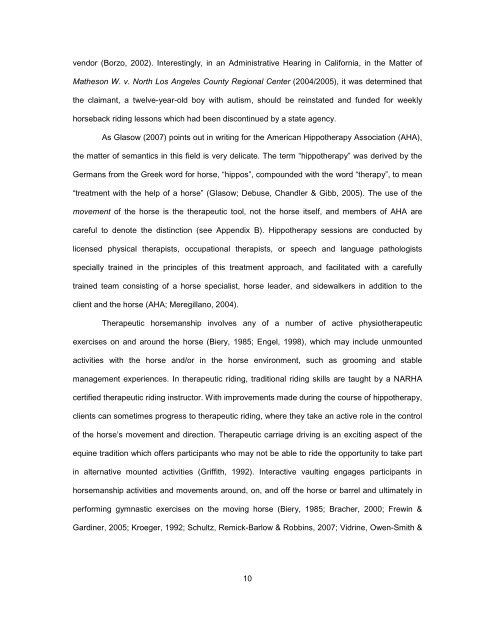A SYSTEMATIC REVIEW OF THE EFFECTS OF PSYCHOTHERAPY ...
A SYSTEMATIC REVIEW OF THE EFFECTS OF PSYCHOTHERAPY ...
A SYSTEMATIC REVIEW OF THE EFFECTS OF PSYCHOTHERAPY ...
Create successful ePaper yourself
Turn your PDF publications into a flip-book with our unique Google optimized e-Paper software.
vendor (Borzo, 2002). Interestingly, in an Administrative Hearing in California, in the Matter of<br />
Matheson W. v. North Los Angeles County Regional Center (2004/2005), it was determined that<br />
the claimant, a twelve-year-old boy with autism, should be reinstated and funded for weekly<br />
horseback riding lessons which had been discontinued by a state agency.<br />
As Glasow (2007) points out in writing for the American Hippotherapy Association (AHA),<br />
the matter of semantics in this field is very delicate. The term “hippotherapy” was derived by the<br />
Germans from the Greek word for horse, “hippos”, compounded with the word “therapy”, to mean<br />
“treatment with the help of a horse” (Glasow; Debuse, Chandler & Gibb, 2005). The use of the<br />
movement of the horse is the therapeutic tool, not the horse itself, and members of AHA are<br />
careful to denote the distinction (see Appendix B). Hippotherapy sessions are conducted by<br />
licensed physical therapists, occupational therapists, or speech and language pathologists<br />
specially trained in the principles of this treatment approach, and facilitated with a carefully<br />
trained team consisting of a horse specialist, horse leader, and sidewalkers in addition to the<br />
client and the horse (AHA; Meregillano, 2004).<br />
Therapeutic horsemanship involves any of a number of active physiotherapeutic<br />
exercises on and around the horse (Biery, 1985; Engel, 1998), which may include unmounted<br />
activities with the horse and/or in the horse environment, such as grooming and stable<br />
management experiences. In therapeutic riding, traditional riding skills are taught by a NARHA<br />
certified therapeutic riding instructor. With improvements made during the course of hippotherapy,<br />
clients can sometimes progress to therapeutic riding, where they take an active role in the control<br />
of the horse’s movement and direction. Therapeutic carriage driving is an exciting aspect of the<br />
equine tradition which offers participants who may not be able to ride the opportunity to take part<br />
in alternative mounted activities (Griffith, 1992). Interactive vaulting engages participants in<br />
horsemanship activities and movements around, on, and off the horse or barrel and ultimately in<br />
performing gymnastic exercises on the moving horse (Biery, 1985; Bracher, 2000; Frewin &<br />
Gardiner, 2005; Kroeger, 1992; Schultz, Remick-Barlow & Robbins, 2007; Vidrine, Owen-Smith &<br />
10
















